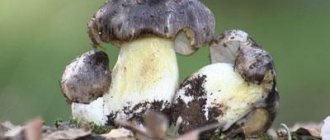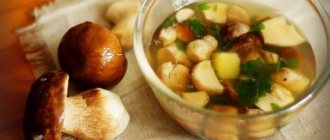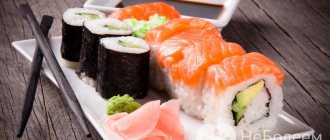Is it possible to get poisoned by porcini mushrooms? A question that interests almost every lover of “silent hunting”. Porcini mushrooms are considered the most valuable find among mushroom pickers.
This is not surprising, because they have a pronounced taste and aroma, and they can also be fried, salted or pickled. However, this type of mushroom can also be dangerous, but the main danger of poisoning comes from false porcini mushrooms.
This article will discuss the types of true and false porcini mushrooms, for what reasons one can be poisoned by these mushrooms, what symptoms arise, and with what methods first aid can be provided.
But are all porcini mushrooms harmless?
In our latitudes there are many look-alike mushrooms, including the porcini mushroom. Such inedible, and even poisonous, brothers as the satanic mushroom, gall mushroom (false boletus), beautiful boletus, speckled oak mushroom, are similar in appearance to white ones. They are very attractive because they are rarely damaged by worms, insects and other forest creatures due to their bitter taste.
Learn to distinguish false mushrooms
Satanic mushroom
belongs to the poisonous section. It differs from white in the appearance of pink color when the leg is broken or cut. Young mushrooms have a faint pleasant smell, old ones have the smell of rotting onions or carrion. It has a bitter aftertaste when cooked. To avoid poisoning, it is necessary to change the water several times when boiling mushrooms. Dangerous if consumed raw. Malaise will occur within 30 minutes after taking it.
False boletus
(the so-called gall mushroom) is inedible. Just like the satanic one, when broken, it turns pink and tastes bitter. False boletus will “manifest itself” 2-3 hours after eating. When consuming a large amount, clinical intoxication can develop within 30-40 minutes.
Edible mushrooms are sometimes difficult to distinguish from inedible ones
Beautiful boletus
is a poisonous mushroom. It differs from the white one by turning blue when cut or broken, and by a bitter taste. It is poisonous only in its raw form. Symptoms of poisoning begin a few hours after consumption.
Wolf boletus
(false satanic mushroom) - becomes edible after 15 minutes of cooking, although there are known cases of poisoning with it, both raw and after cooking. When a fresh mushroom is damaged, the flesh becomes bluish.
Speckled oakweed
- conditionally edible. Unlike false boletus, when cut, the flesh of its stem turns blue. Looks like white. May cause irritable bowel syndrome if consumed raw or undercooked.
When picking mushrooms, sometimes doubts arise about its edibility. Dangerous doubles of the porcini mushroom have a certain aftertaste: sweetish, bitter. But never taste raw mushrooms - some of them are very poisonous. In the forest, you will not be able to get the help you need.
If, after all, such mushrooms (false boletus, oak boletus and others) end up in your basket, they will spoil the entire harvest with bitterness. When cooked, the bitterness will warn you against eating mushrooms. But in canned form, flavor enhancers and preservatives will mask it, and symptoms of poisoning may occur when consuming such products.
Do not taste raw mushroom!
It is necessary to be especially careful with dubious home preserves, which are sold in markets, on highways passing through villages, and in spontaneous places of sale.
How to identify a deceiver?
Poisonous counterparts of porcini mushrooms also have an impeccable and presentable appearance. They grow in colonies next to their edible counterparts and mislead inattentive mushroom pickers.
The false satanic mushroom looks like an ordinary representative of the boletus genus. Knowing its distinctive features can save someone's life:
- the color of the cap with a diameter of up to 30 centimeters varies from gray (olive) to brown;
- the tubular layer and the fibrous stalk with a mesh structure are colored predominantly orange or deep red;
- the cut flesh turns blue within 5 minutes;
- pungent unpleasant onion smell.
The second famous deceiver is the gall mushroom, which is popularly called mustard because of its characteristic taste. It does not belong to the boletus species, but is extremely similar to them:
- has the greatest similarity with pine and oak porcini mushrooms;
- a convex brown cap and a cylinder-shaped stem thickened at the base;
- the tubular layer is porous and has an unpleasant pinkish or dirty white hue;
- When cut, the flesh also changes color to pink.
The most important feature of bitterling is its attractive appearance, because not a single forest dweller touches it. Domestic reference books recommend testing a suspicious mushroom for bitterness by tasting it. However, foreign scientists believe that this mushroom is so toxic that toxic substances are quickly absorbed even through the mucous membrane.
What troubles might lie in wait?
When ingested, the toxins contained in mushrooms are gradually absorbed into the blood and enter the liver. Therefore, in case of poisoning, it is the liver cells – hepatocytes – that are the first to suffer, as they try to neutralize toxic substances. If the liver tissue fails to neutralize the poison, the latter is carried by blood throughout the body. The central nervous system and kidneys are the most susceptible to toxins.
The brain reacts with dizziness and nausea. Irritation of the subcortical nuclei leads to increased heart rate, breathing, a drop in blood pressure, and the urge to vomit. The second organ that tries to neutralize and remove toxic substances from the body is the kidney. Lower back pain and urinary disorders may develop.
Local toxic effects on the mucous membrane of the gastrointestinal tract lead to spastic contractions of the stomach and vomiting. Irritation of the intestinal wall leads to increased peristalsis, the release of large amounts of fluid and diarrhea. The toxic dose also depends on the fullness of the stomach before the poison enters the body. This is related to the time of onset of the first symptoms of poisoning.
Signs of mushroom poisoning
Dizziness, nausea, retching and vomiting, diarrhea (diarrhea) is a signal to begin emergency measures. In severe cases, seizures and loss of consciousness may occur. Continued vomiting and diarrhea lead to dehydration and loss of electrolytes. In this case, specialized medical care is needed, possibly even in a medical facility.
What needs to be done before the doctor arrives?
The first aid for mushroom poisoning is gastric lavage. The presence of other foods will increase the residence time (slow down the passage) of toxins in the stomach, thereby facilitating the absorption of more of them into the blood.
You need to drink 500-700 ml (2-3 glasses) of lightly salted water (2 tablespoons of salt per 5 liters of water) at body temperature and artificially induce vomiting. Repeat the procedure several times until the stomach is cleared of all food masses. Therefore, the rinsing solution must be prepared in advance (about 10 liters).
The first cure for mushroom poisoning
After this, it is necessary to take intestinal sorbents for an hour every 15 minutes to prevent further entry of toxins into the blood. The most basic drug that is found in every first aid kit, including a car one, is activated carbon. Other medicines you can take are “Sorbex”, “Polysorb”, “Enterosgel” in accordance with the instructions indicated on the package.
Over the next 24 hours, it is advisable to fast and limit yourself to drinking boiled water. Under normal conditions, the rate of water intake is 30 ml per kilogram of body weight; in case of intoxication, you need to drink up to 35-40 ml per 1 kg. By diluting the blood with liquid, the concentration of toxic wastes decreases and their removal from the body is accelerated.
Limit physical activity. Be in the temperature comfort zone. The body must conserve energy reserves to combat internal dangers. In the future, you can consume pureed vegetable soups, slimy rice water, thin rice porridge, and herbal teas. Until complete recovery, you should refrain from aggressive foods: hot, spicy, sour, fried, alcohol.
It is impossible to deny yourself the pleasure of going on a “quiet hunt”!
Collect mushrooms wisely!
Mushroom picking is not only done by professionals. “Green tourism” is gaining momentum. Walking, walking distances over rough terrain, the smell of pine needles - all this only strengthens your health. “Silent hunting” is an interesting and useful activity. And if there are doubts about the edibility of your find, it is best not to cut it off or taste it on your tongue. Moreover, you shouldn’t throw it in a basket and take it home. Remember that there are false double mushrooms. Poisoning them can lead to serious consequences.
First aid and treatment
What to do if you are poisoned by porcini mushrooms? First you need to call an ambulance. First aid should be provided before the doctors arrive.
- Rinse the stomach: drink up to 1 liter of boiled water and induce vomiting (by pressing on the root of the tongue with a spoon). Repeat until the rinsing water is clear.
- Give any sorbent in a dose of 0.5–1 g/kg body weight (“Enterosgel”, “Polyphepan”, “Activated carbon” or others).
- Give a cleansing enema.
- Provide plenty of fluids.
After examining and assessing the severity of the patient’s condition, the doctor decides whether the patient needs to be hospitalized in the toxicology department. Symptomatic treatment is provided in the hospital:
- fight against intoxication and dehydration;
- vitamin therapy;
- hepatoprotectors (for liver dysfunction);
- cardiac (if necessary);
- enzymes, etc.
Let's summarize - poisoning by boletus mushrooms, possibly if false porcini mushrooms (gall and satanic) are used instead, if they are stored for a long time after collection, if they are contaminated with toxic substances (you should not buy mushrooms at spontaneous markets), or microorganisms. Also, trouble will not be long in coming if you eat them with alcohol, due to protein intolerance, when using metal utensils or eating old, wormy mushrooms. In case of poisoning, you must call an ambulance and begin providing first aid to the victim - gastric lavage, cleansing enema, taking sorbents and drinking plenty of fluids.
Video
Be sure to watch this video and learn a lot of valuable information about poisonous twin mushrooms.
Taxonomy:
- Division: Basidiomycota (Basidiomycetes)
- Subdivision: Agaricomycotina (Agaricomycetes)
- Class: Agaricomycetes (Agaricomycetes)
- Subclass: Phallomycetidae (Veselkov)
- Order: Phallales
- Family: Phallaceae
- Genus: Mutinus (Mutinus)
- Species: Mutinus ravenelii (Smelly morel)
- Other names for the mushroom:
Other names:
- Mutinus ravenel
- Morel smelly
Description:
Fruiting body
: goes through two stages - a light, elongated, pointed egg measuring 2-3 cm under a thin yellowish membranous skin contains a bright, red-pink “leg” rudiment, covered with a delicate white film.
The egg ruptures with two lobes, from which a porous, hollow “leg” rises, 5-10 cm long and approximately 1 cm in diameter, pinkish in color with a red-crimson, thickened tuberculate tip approximately in the middle. When ripe, the tip of Mutinus Ravenelle is covered at the end with a thick brown-olive smooth, smeared spore-bearing mucus. The mushroom emits an unpleasant, strong smell of carrion, which attracts insects, mainly flies. Pulp
: porous and very tender.
Habitat:
From the last ten days of June to September, the stinking morel grows on humus-rich soil in deciduous forests, in gardens, near rotting wood, in bushes, in damp places, after and during warm rains, in a group, not often in the same place, like and the previous species, rare.
Edibility:
Morel stinky -
Inedible mushroom
Similarities:
The smelly morel is very similar to. Even specialists who did not expect such a tropical gift could not distinguish them for twenty years, until 1977. This was done by Latvian mycologists. At present, several external differences can be pointed out. At the first stage, the ovoid fruiting body of this species breaks into two petals. The stinking morel has a brighter, crimson tint of the tip, the tip itself is thicker, and the dog mutinus has a tip diameter no larger than the rest of the stem. The spore-bearing mucus (gleba) in Mutinus Ravenelli is smooth, not cellular.
There are about 2,500 species of row mushrooms, forming a large family that includes edible, conditionally edible, inedible and poisonous mushrooms. These fruiting bodies grow in mixed or coniferous forests, preferring sandy soils or loam. The peak of mushroom picking occurs at the end of August and continues until mid-October. Usually the smell of edible rows is pleasant and delicate, reminiscent of perfume. You can prepare any dish from them, as well as prepare them for the winter:
marinate, fry or salt.
Dimensions of an overgrown champignon
All champignons sold in stores have approximately standard sizes, and their cap rarely exceeds 5 cm in diameter. In their natural growing environment, these mushrooms can significantly exceed these indicators, often reaching 8–10 cm in diameter (sometimes more). It is the latter that are considered “overgrown” and are used for food extremely rarely, mainly for frying or preparing minced mushrooms or rolls.
Did you know? Champignons are an excellent dietary product that can be used as part of various diets. There are only 30 kcal per 100 g of boiled mushrooms, and there are even fewer calories in a canned product: approximately 20 kcal per 100 g.
The smell of purple and white rows during cooking
How the row plant smells will depend on the type: whether it is edible or not. Note that most of these fruiting bodies still have a specific mealy odor and bitter taste. Some row mushrooms even smell like dust or laundry soap.
For example, the violet row, considered a conditionally edible mushroom, smells of perfume. After a long soaking of 2 to 3 days, it needs to be boiled for 30 minutes in salted water with the addition of citric acid. Only after this the smell of violet row disappears, it can be pickled, salted or fried.
This row grows in any forest, but avoids places with high humidity. The purple row is similar to the purple cobweb - a poisonous mushroom. It should absolutely not be eaten, as the mushroom is very toxic. A distinctive feature of the cobweb is a cap covered with cobwebs.
Another type of row that has a dusty smell is white row. Being a poisonous mushroom, it has not only an unpleasant odor, but also a bitter taste. Experienced mushroom pickers always avoid this row, although it disguises itself as a champignon or young porcini mushroom. If you cut it, the pungent smell of dust immediately makes it clear what kind of mushroom it is. White row grows in small groups or alone. It can be found not only in dense forests dominated by birch trees, but also in park areas, groves or meadows. Some mushroom pickers claim that when a white row is broken, it smells like gas or laundry soap. Young specimens of this poisonous mushroom have a weaker odor than mature representatives. Even after prolonged soaking and cooking, the smell of white row does not disappear. But this process is not necessary, because the mushroom is poisonous.
To take or not to take?
Some mushrooms that were traditionally collected in the old days really shouldn’t be put in a basket now: the ecology and the substances that mushrooms can accumulate from the soil have changed (pesticides, heavy metals, radionuclides), which leads to a toxic effect in our body. One serving of fried pigs won't do anything, but eating them for a long time can cause damage to liver cells. It is thanks to the environmental situation that has changed for the worse that mass poisonings from edible mushrooms occur in one area or another.
When going into the forest in an unfamiliar place, you need to consider the following rules:
- Collect edible mushrooms - only young and fresh ones, do not take old mushrooms.
- Go for mushrooms only in ecologically clean areas, far from large factories, garbage dumps, chemical plants, and megacities.
- Do not pick mushrooms along highways.
- Mushrooms should be processed, cooked and preserved according to the recipes of experienced housewives and books.
- Do not buy canned mushrooms from unfamiliar sellers.
- Sorting and processing mushrooms should not be delayed for more than 5-6 hours, otherwise they will become more wormy than they were when they were cut. There is no need to let the worms feast all night; they can cause quite noticeable damage to the mushrooms.
Taste qualities of rows
In terms of taste, edible and conditionally edible rows are practically no different from other mushrooms that can be eaten. However, many mushroom pickers, especially beginners, are afraid to collect them, because all rows have an interesting bright or pale color, which is characteristic of some false doubles and even toadstools. That is why it is very important to be able to distinguish between edible types of rows.
Don’t forget the main rule of a mushroom picker:
“If you’re not sure, don’t take it!”
. Collect only those types of mushrooms that you are sure of. And if there is even the slightest doubt, it is better to abandon the idea of putting mushrooms in a basket. In addition, the smell of the rows speaks volumes: if it is unpleasant, has a powdery or dusty aroma, the mushroom is poisonous.
It’s an enviable success to pick a basket of porcini mushrooms; they can be dried, marinated for the winter, frozen and made into aromatic mushroom soup. However, such luck often turns into an unpleasant surprise in the form of symptoms of poisoning. Then it turns out that those same treasured porcini mushrooms turned out to be false. The false porcini mushroom, or bitter bitter in other words, has learned to masquerade as its noble brother in such a way that it is capable of deceiving not only beginners - lovers of “quiet hunting”. I’ll tell you how to recognize a false porcini mushroom in this article.
The noble white mushroom is a desirable prey among mushroom pickers; it is valued for properties such as:
- Porcini mushroom belongs to the first category and has an appetizing aroma;
- The mushroom pulp is firm and crispy, the taste characteristics are excellent;
- The nutrients of the mushroom are absorbed by the human body faster than those of other mushrooms. Porcini mushrooms are easier to digest and digest;
- When pickled, the mushroom is hard and crunchy, its flesh is not flabby;
- After defrosting, the porcini mushroom does not lose its taste;
- Porcini mushroom soup has a light color, which is excluded when other noble mushrooms are added when it becomes dark;
- Dishes made from porcini mushrooms have a special aroma.
A real porcini mushroom has a beautiful brown cap, it is rather straightened and has a matte surface. When cut, the mushroom does not change color.
The white mushroom grows in coniferous and deciduous forests, preferring the presence of pine trees or fir trees nearby.
The flesh of the mushroom on the cap is always easily separated from the tubular layer, the tone of which turns yellow. The stem of the mushroom is predominantly white, thickening towards the bottom.
In the forest and when harvested, porcini mushrooms have virtually no odor; an appetizing aroma appears during cooking. Dried mushrooms have the strongest aroma.
Representatives of the boletus family
The white mushroom owes its name to those times when the priority method of processing was drying, which facilitated easy digestion. Its flesh did not lose its attractive color, and no one had any idea whether it was possible to be poisoned by dried porcini mushrooms. In modern unfavorable environmental conditions, you need to be aware of the distinctive features of porcini mushrooms:
- the cap is convex, dome-shaped, has a color from milky to light brown, reaches a diameter of 30 centimeters or more;
- the leg, up to 25 centimeters high, is usually lighter than the cap, has a pear shape and is covered with a network of almost imperceptible veins;
- the pulp is juicy, fleshy, does not darken when cut;
- It has a pleasant mushroom aroma and spicy taste.
The beginning of the boletus collection season depends on the area in which they grow; they need a week to reach full maturity. In southern latitudes they grow from May to October, in northern latitudes - from June to September (harvest in August). The boletus genus is represented mainly by edible mushrooms:
- reticulated white has a brown cap and a short leg of the same color and ocher veins;
- copper (hornbeam) boletus is distinguished by a brown cylindrical leg and a dark bronze cap;
- birch (spike) - a very light (less often cream-colored) mushroom with a small cap diameter (about 15 centimeters) and a thick, low-growing stalk;
- pine (pine) is known for its large reddish-brown cap with a purple tint on a milky white stem, the flesh under the cap is light brown;
- oak mushroom is not as dense as other boletus mushrooms. Its cap is gray-brown and often has light spots;
- The spruce porcini mushroom has a chestnut color and a stem thickened downward.
How to recognize a false white mushroom
The false porcini mushroom is not poisonous, however, its pulp has such a bitter taste that even a small piece of it can nullify all culinary delights, turning the dish inedible due to unbearable bitterness.
In appearance, the gall mushroom is similar to a real white one, only after precipitation its cap becomes somewhat sticky. Young gall mushrooms have a convex cap, which becomes flat with age. The tone of the cap varies somewhat, it can be brown or yellow.
The legs of the false porcini mushroom are flesh-colored or yellowish in color, and they are thickened at the base. Interestingly, adult mushrooms have an unpleasant odor, similar to rotting onions, by which they are quite easy to distinguish. However, young inedible mushrooms have no smell.
Bitterweed grows in the same place as its noble brothers, preferring secluded edges, coniferous, deciduous forests and pine forests.
You can see the mushroom as early as mid-July, around the same time as the summer wave of porcini mushrooms passes.
What you need to know about mushrooms
Poisoning by poisons of animal or plant origin ranks fourth in frequency of cases. Moreover, 85% of all poisonings are caused by a toxic component, which includes pale toadstool, false porcini mushroom or fly agaric.
Boletus, boletus and boletus are valuable food products, as they contain:
- useful microelements in the form of potassium, phosphorus, calcium, sulfur and magnesium;
- they are rich in vitamins A and B;
- the protein concentration exceeds its content in the egg;
- belongs to products with a low calorie content, due to the reduced concentration of carbohydrates and fats.
In addition, this product has a number of medicinal properties, which are manifested as follows:
- stimulate the production of gastric juice, which has a beneficial effect on the gastrointestinal tract;
- prevent the development of oncological processes;
- prevent the development of atherosclerotic plaques on the vascular walls;
- strengthen the immune status of the body.
You need to know that boletus poisoning is not the only danger that can arise from their consumption. Failure to comply with preservation technology can cause severe poisoning due to botulism in mushrooms. Botulinum toxin is produced by clostridia, which has the peculiarity of developing in the absence of air access.
How to distinguish a false white mushroom from a real one
Gorchak and real porcini mushroom have more similarities than differences, so when collecting you need to be especially careful and pay attention to details such as:
- The false porcini mushroom has a pinkish spongy layer, while the real one has an olive-yellow layer;
- The porcini mushroom has no aroma; in adult specimens of the false mushroom it is nauseating, similar to the smell of spoiled onions;
- On the stem under the cap itself, the bitter mushroom has characteristic dark patterns; the stem of the porcini mushroom is evenly colored;
- On a cut of bitterling mushroom, the flesh instantly turns pink, while a cut from a porcini mushroom has no color;
- If you lick the cut of a false mushroom, you will feel a strong bitterness, which is impossible with its noble brother.
Conducting a taste test, as they say, is the most effective way to distinguish an edible mushroom from an inedible one. However, you need to be extremely careful. The bitterness should be spat out, and if possible, rinse your mouth with water.
What mushrooms are edible and where do they live?
Boletus mushrooms do not hide their age, so it is not difficult to distinguish an overripe mushroom:
- its flat top is several shades darker, the peel is easily separated from the pulp;
- the leg stretches out and thickens at the cap and base;
- the pulp turns yellow and acquires a fibrous structure;
- in rainy weather the mushroom becomes covered with a mucous coating;
- the presence of cracks, which indicates damage.
Mushrooms should only be collected in their habitats, which differ depending on the species. All boletus prefer a temperate climate, deciduous, coniferous and mixed forests. The priority soil for porcini mushrooms is loamy, sandy or marshy, often in the vicinity there are mosses and lichens.
What are the signs of mushroom poisoning
A false porcini mushroom can be a real challenge for a mushroom picker. Its toxins can penetrate the bloodstream upon contact with the skin. As a result, headaches, weakness, and muscle discomfort appear.
Despite the fact that such ailments pass fairly quickly, after a couple of days or even a week, disturbances in liver function may appear.
If such symptoms occur, you need to consult a doctor in a timely manner so that the ailments do not turn into cirrhosis of the liver.
In recent years, a dangerous trend has emerged among mushroom pickers - to eat even inedible mushrooms. They claim that even toadstools can become a delicacy if prepared correctly.
However, it is not. Even with long and thorough soaking, toxic substances remain in the false porcini mushroom, which slowly but surely poison the human body, causing the main blow to the liver.
There is no need to waste personal time collecting toxic mushrooms; health is always more valuable, even if false mushrooms resemble noble ones, which are difficult to pass by.
Causes of poisoning
Unfortunately, even healthy, tasty, aromatic boletus mushrooms are no exception - they can also be poisoned. There are many reasons for porcini mushroom poisoning.
Consumption of false porcini mushrooms (gall and satanic), which are similar in appearance to ordinary boletus mushrooms.
- The collected porcini mushrooms were kept at room temperature for over 3 hours before cooking.
- The prepared dish was not stored in the refrigerator, which caused bacterial contamination.
- Tasty boletus mushrooms are loved not only by people and forest “dwellers,” but also by worms, which secrete toxic metabolic products into the mushroom pulp, causing poisoning when consumed.
- The place where porcini mushrooms were collected was located near a highway, railway lines, industrial or radiological zone, and they actively absorbed harmful toxic substances from the soil or air.
- Insufficient cleaning of mushrooms before hermetically sealing pickled edible boletus mushrooms can cause the botulism pathogen to enter the jar.
- Use for salting aluminum or galvanized cookware.
- Consumption of overripe, old mushrooms, which contain toxic products of protein decomposition.
- Individual intolerance to mushroom protein.
- Alcohol, when consumed together with boletus mushrooms, dissolves the toxin they contain - coprine (it does not dissolve in digestive juices without alcohol), which causes severe poisoning.
What you need to know when going mushroom hunting
Mushroom picking will be a pleasure if you prepare for it properly. It’s good to find out in advance what kind of mushrooms are native to your forest, including edible ones and those that are unsuitable for food. This is necessary so that before going into the forest you can carefully examine them in pictures and photographs, noting their distinctive features. Advanced mushroom pickers use a mushroom directory on their phone, which is very convenient.
If you come across unfamiliar mushrooms in the forest, you need to take one of them and consult with a knowledgeable mushroom picker, and gradually you will become a knowledgeable lover of “quiet hunting”.
It’s better to walk through the forest with a basket, so you’ll get the mushrooms back intact. If you put the gifts of the forest in a bag, then when you pass through the thickets, its contents will turn into mush.
If the forest is unfamiliar to you, it is a good idea to take a compass with you. On a clear day it is convenient to navigate by the sun.
Mushrooms! Mushroom soup! Yummy!!! And what a pleasant smell of dried mushrooms, especially white mushrooms! When we enter the forest, we sometimes say: “It smells like mushrooms.” But what is the mushroom smell? How is it formed or, figuratively speaking, what does it consist of?
In general, scientifically speaking, smell does not exist in nature.
. Smell is a complex mechanism and psychophysiological process that forms virtual sensations in the human brain, which are obtained as a result of contact of volatile chemicals with special olfactory receptor cells located in the human nasal cavity. A molecule of a substance, in contact with a receptor cell, causes an electrical signal in it. It is transmitted along nerve fibers to the brain and sensations, which we call smell, are already “built” there.
It all depends on three factors
: (1.) cleanliness of the nasal cavity, (2.) sensitivity of receptors and (3.) chemical composition of substances. When it comes to mushrooms, it turns out that hundreds of different volatile chemical compounds are involved in the formation of the mushroom smell. They can be determined using analyzer devices. But it's not that simple. It turns out that the nose is such a delicate instrument that sometimes capturing single molecules gives incredible sensations. However, more about this in the material below.
PS. A large photo of a boletus (127 kb) can be downloaded at https://bp21.org.by/p/book/bpwh86.jpg
Georgy Kozulko Belovezhskaya Pushcha
(Write your reviews, thoughts, ideas, questions, comments or disagreements in the comments below (anonymous users sometimes need to enter coded English text
from the picture) or send it to my email address: )











